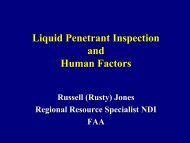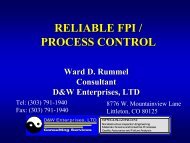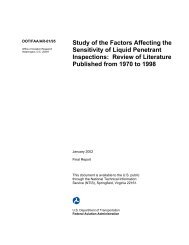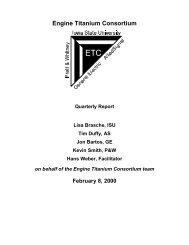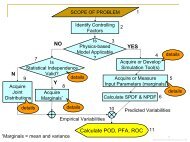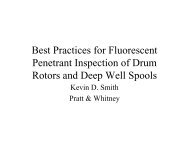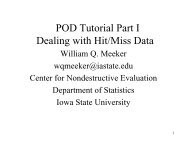Engine Titanium Consortium - Center for Nondestructive Evaluation ...
Engine Titanium Consortium - Center for Nondestructive Evaluation ...
Engine Titanium Consortium - Center for Nondestructive Evaluation ...
Create successful ePaper yourself
Turn your PDF publications into a flip-book with our unique Google optimized e-Paper software.
fixed-focus transducers that were not readily available. We note that 6"-diameter billet was chosen<br />
<strong>for</strong> these initial experiments because existing transducers were available which could approximately<br />
focus a sound beam near the back wall in such a billet (one of the focal conditions of chief interest).<br />
#4 FBHs were then chosen to simulate internal defects, because such targets were large enough to<br />
be easily seen <strong>for</strong> the range of focal conditions being investigated.<br />
C-scan images <strong>for</strong> four measurement trials are shown in the upper panels of Figures 1-4,<br />
respectively. The upper-left panel of each figure shows the rectified peak amplitude of the BW<br />
echo as a function of position <strong>for</strong> a full-round inspection of the 15”-long billet section. The upperright<br />
panel displays images of the FBHs, obtained by per<strong>for</strong>ming a second scan at increased gain,<br />
using a time gate that enclosed the FBH echoes, but excluded the BW echoes. Annotations on the<br />
upper panels list the peak FBH amplitudes and the average BW amplitudes in small regions<br />
centered about each FBH location. In all cases, the listed amplitudes are the percentage of Full<br />
Screen Height (FSH). One notices in each figure that the BW and FBH both amplitudes vary<br />
considerably, and that large (small) FBH amplitudes are usually associated with large (small) BW<br />
amplitudes at similar positions.<br />
The correlation between FBH and BW amplitudes is further illustrated in the lower panels of Figures<br />
1-4. For each of the four inspections, the absolute amplitudes of the BW and FBH signals have<br />
been adjusted to have a mean value of 50% FSH <strong>for</strong> the suite of FBH targets. These rescaled<br />
amplitudes are shown in the lower-left panel, with the principal FBH targets numbered 1-13 (from<br />
top to bottom and left to right in the C-scan images). The lower-right panels display "correlation<br />
plots" of the rescaled FBH amplitudes versus the rescaled BW amplitudes. If there were perfect<br />
correlation between the two types of echoes, the plotted points would all fall along a straight line<br />
passing through the origin and having a slope of unity. In each case, a best-fit line through the<br />
origin is shown, and its slope is seen to be close to the ideal value of 1 in each case. Overall, the<br />
BW and FBH amplitudes were found to be generally well correlated, with the degree of correlation<br />
being largest when the beam was focused near the FBH targets.<br />
The results summarized in Figures 1-4 indicate that BW echoes can be used to track attenuation<br />
variations within a billet. Presumably, BW echoes can also be used to ascertain the attenuation<br />
difference between a billet under inspection and a calibration standard. Because of the significant<br />
variation in BW and FBH amplitudes with billet position, the results suggest that attenuation<br />
compensation procedures should make use of extreme BW amplitude data values rather than only<br />
average values.<br />
Quarterly Report – January 1, 2002 –March 31, 2002<br />
print date/time: 6/6/2002 - 8:39 AM – Page 24



